1993 CADILLAC SEVILLE check engine light
[x] Cancel search: check engine lightPage 25 of 407
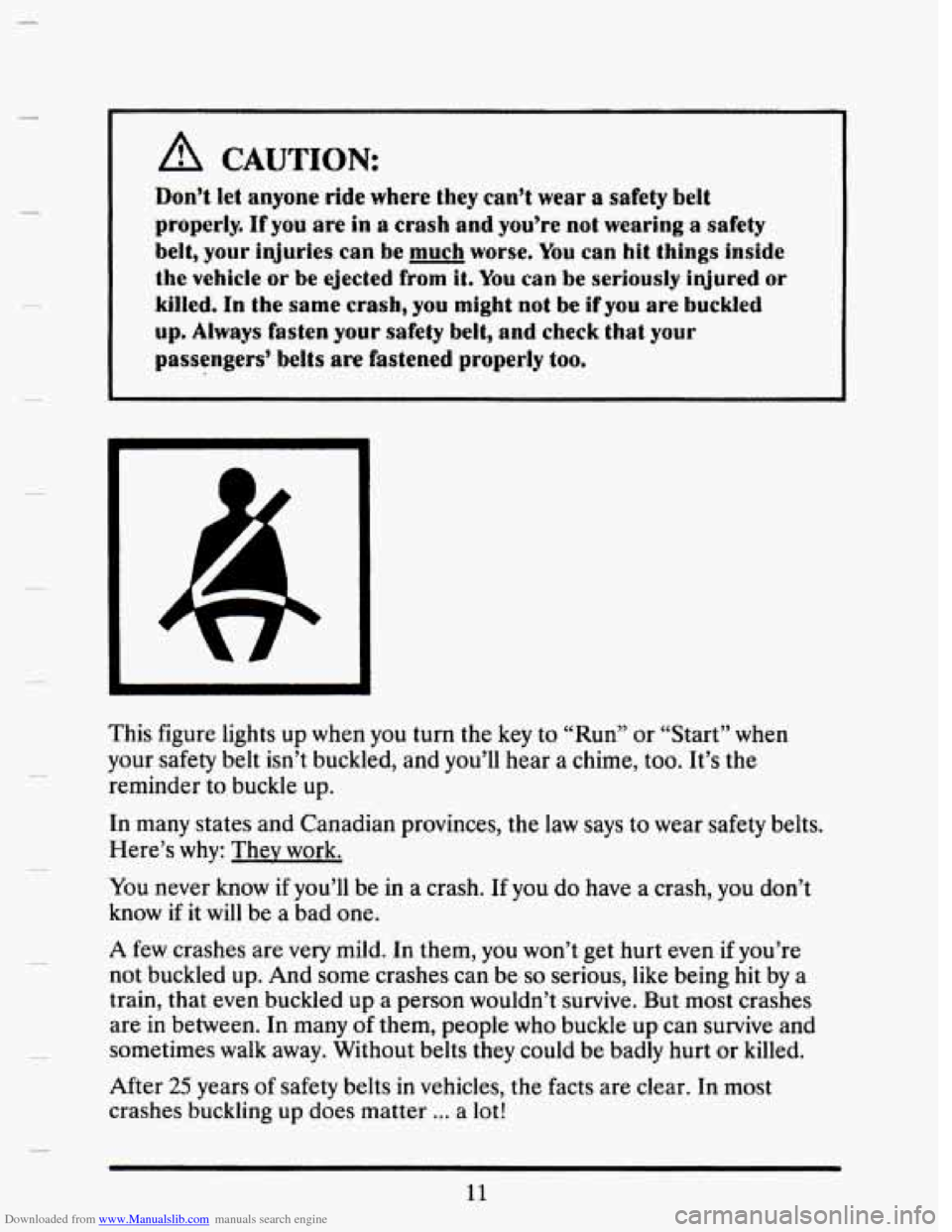
Downloaded from www.Manualslib.com manuals search engine c
A CAUTION:
Don’t let anyone ride where they cadt wear a safety beIt
properly. If you are in a crash and you’re not wearing a safety
belt, your injuries can be much worse, You can hit things inside
the vehicle or be ejected from it. You can be seriously injured or
killed. in the same crash, you might not be if you are buckled
up. Always fasten your safety belt, and check that your
passengers’ belts are fastened properly too.
This figure lights up when you turn the key to “Run” or “Start” when
your safety belt isn’t buckled, and you’ll hear a chime,
too. It’s the
reminder to buckle up.
In many states and Canadian provinces, the law
says to wear safety belts.
Here’s
why: They work.
You never know
if you’ll be in a crash. If you do have a crash, you don’t
know
if it will be a bad one.
A few crashes are very mild. In them, you won’t get hurt even if you’re
not buckled up. And some crashes can be
so serious, like being hit by a
train, that even buckled up a person wouldn’t survive.
But most crashes
are
in between. In many of them, people who buckle up can survive and
sometimes
walk away. Without belts they could be badly hurt or killed.
After
25 years of safety belts in vehicles, the facts are clear. In most
crashes buckling
up does matter ... a lot!
Page 45 of 407
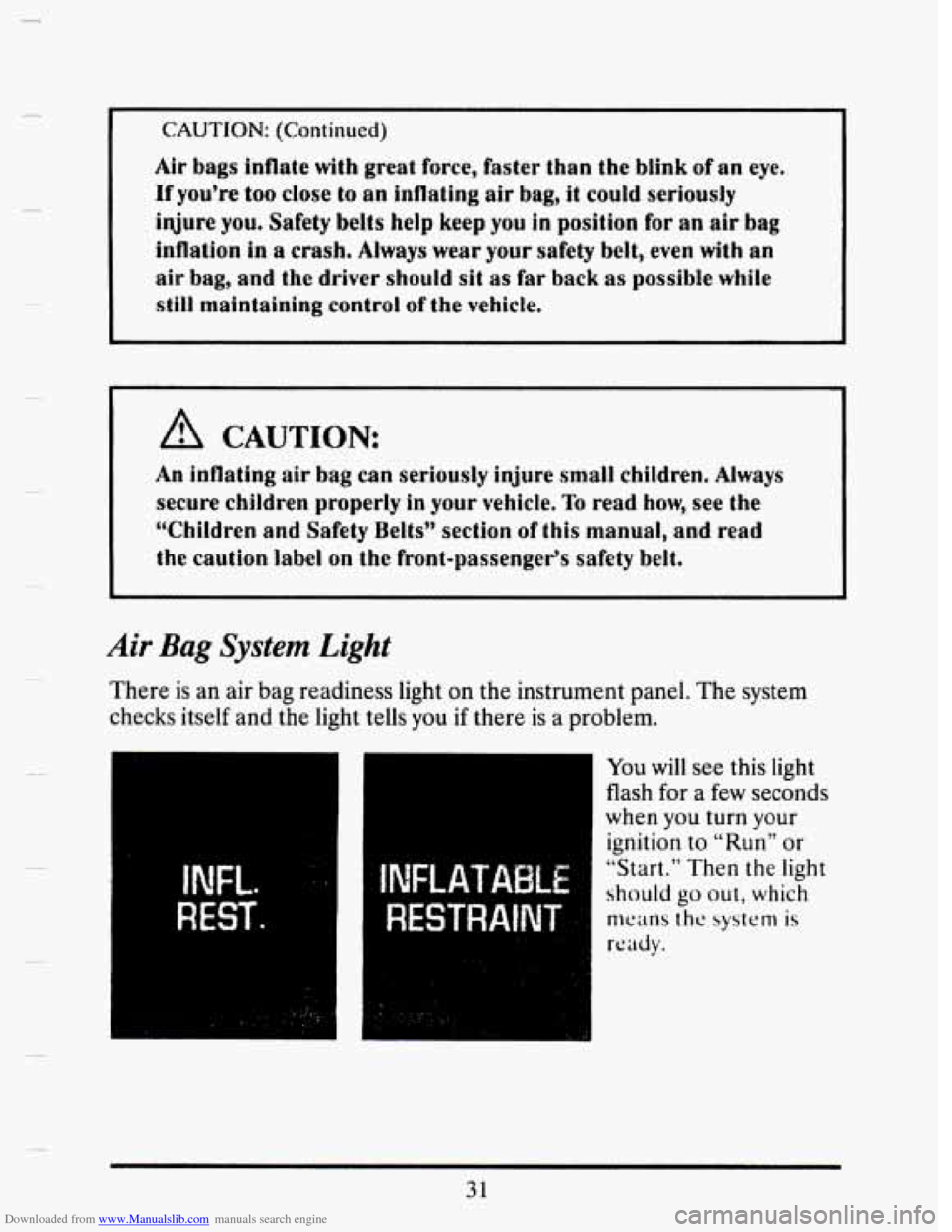
Downloaded from www.Manualslib.com manuals search engine CAUTION: (Continued)
Air bags inflate with great force, faster than the blink of an eye.
If you’re too close to an inflating air bag, it could seriously
injure
you. Safety belts help keep you in position for an air bag
inflation in a crash. Always wear your safety belt, even with an
air bag, and the driver
should sit as far back as possible while
still maintaining control of the vehicle.
A CAUTION:
An inflating air bag can seriously injure small chiIdren. Always
secure children properly in your vehicle. Tu read how, see the
“Children
and Safety Belts’’ section of this manual, and read
the caution
label on the front-passenger% safety belt.
Air Bag System Light
There is an air bag readiness light on the instrument panel. The system
checks itself
and the light tells you if there is a problem.
INFL. ..
REST.
You will see this light
flash
for a few seconds
when you turn your
ignition to “Run” or
“Start.” Then the light
should go out, which
means the system is
ready.
INFLATABLE
RESTRAINT
..
31
Page 83 of 407

Downloaded from www.Manualslib.com manuals search engine r
r
r- I I
I
r
P
I i
c I
I 1
1
r
interference, and (2) This device must accept any interference recelvea,
including interference that may cause undesired operation.
: ..
Should interference to this system occur, try this:
Check to determine if battery replacement is necessary. See the
0 Check the distance. You may be too far from your vehicle. This
Check the location. Other vehicles or objects may be blocking the
See your Cadillac dealer or a qualified technician for service.
Changes
or modifications to this system by other than an authorized
service facility could void authorization to use this equipment.
.. . . .. :. ::< ., .. 7 >; <<. - ".
instructions on battery replacement.
product has a maximum range.
signal.
Operation
m
0 Press this symbol to
unlock the driver's
door. Press
it again
within
4 seconds to
unlock the other
doors. Pressing this
button
will also
disarm the Theft
Deterrent System
and turn on the
interior lights.
0 Press this symbol to
lock your doors.
This also arms the
Theft Deterrent
System.
r
I
69
Page 91 of 407
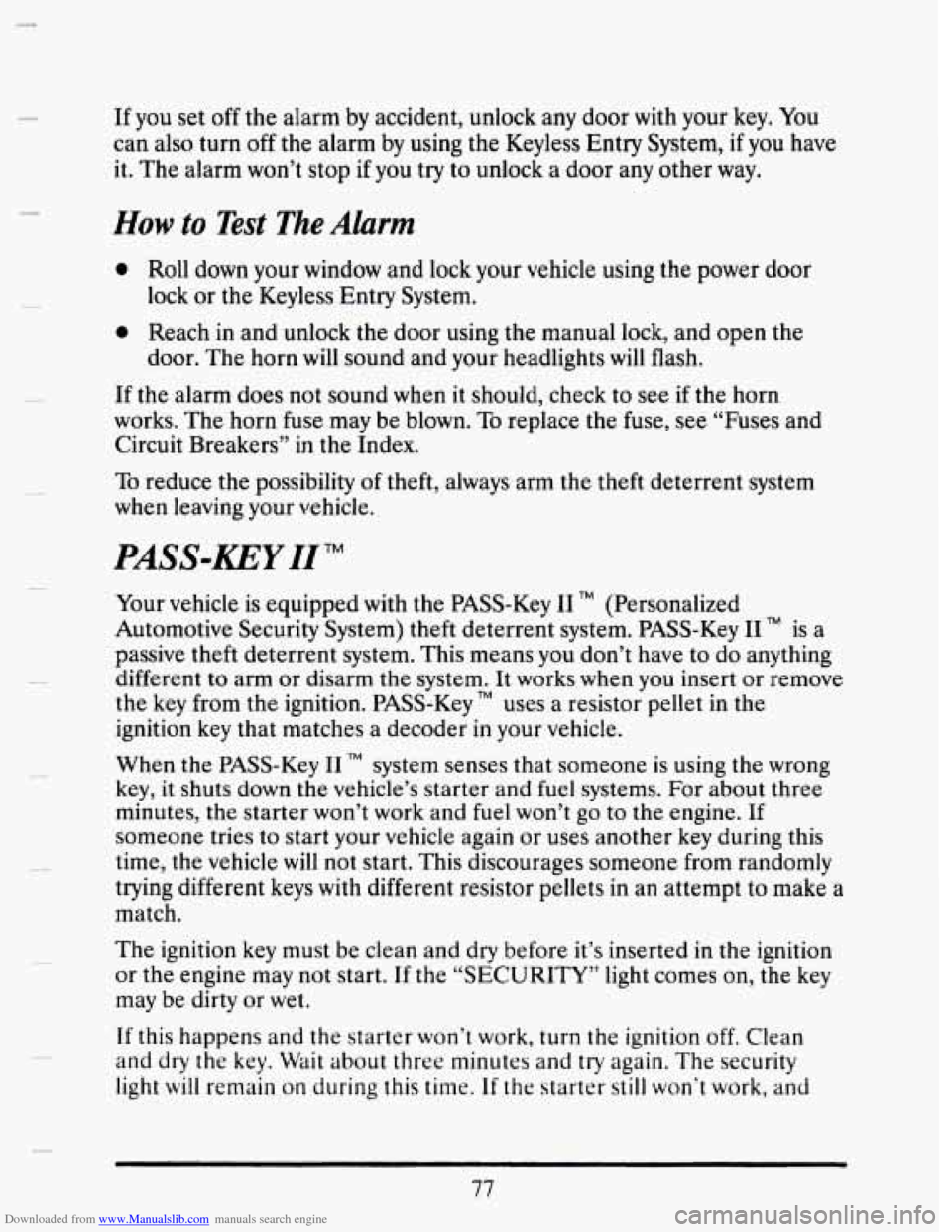
Downloaded from www.Manualslib.com manuals search engine If you set off the alarm by accident, unlock any door with your key. You
can also turn
off the alarm by using the Keyless Entry System, if you have
it. The alarm won’t stop
if you try to unlock a door any other way.
How to Test The Alarm
e Roll down your window and lock your vehicle using the power door
lock or the Keyless Entry System.
e Reach in and unlock the door using the manual lock, and open the
If the alarm does not sound when it should, check to see if the horn
works. The horn fuse may be blown.
To replace the fuse, see “Fuses and
Circuit Breakers” in the Index.
door. The horn
will sound and
your headlights will flash.
To reduce the possibility of theft, always arm the theft deterrent system
when leaving your vehicle.
PASS-KEY 11 TM
Your vehicle is equipped with the PASS-Key I1 TM (Personalized
Automotive Security System) theft deterrent system. PASS-Key I1
TM is a
passive theft deterrent system. This means you don’t have to do anything
different to arm or disarm the system. It works when you insert or remove
the key from the ignition. PASS-Key
’“ uses a resistor pellet in the
ignition key that matches a decoder
in your vehicle.
When the PASS-Key
I1 TM system senses that someone is using the wrong
key,
it shuts down the vehicle’s starter and fuel systems. For about three
minutes, the starter won’t work and fuel
won’t go to the engine. If
someone tries
to start your vehicle again or uses another key during this
time, the vehicle
will not start. This discourages someone from randomly
trying different keys with different resistor pellets in an attempt
to make a
match.
The ignition
key must be clean and dry before it’s inserted in the ignition
or the engine may not start. If the “SECURITY” light comes
on, the key
may be dirty or wet.
If this happens and the starter won’t work, turn the ignition off. Clean
and
dry the key. Wait about three minutes and try again. The security
light
will remain on during this time. If the starter still won’t work, and
Page 92 of 407
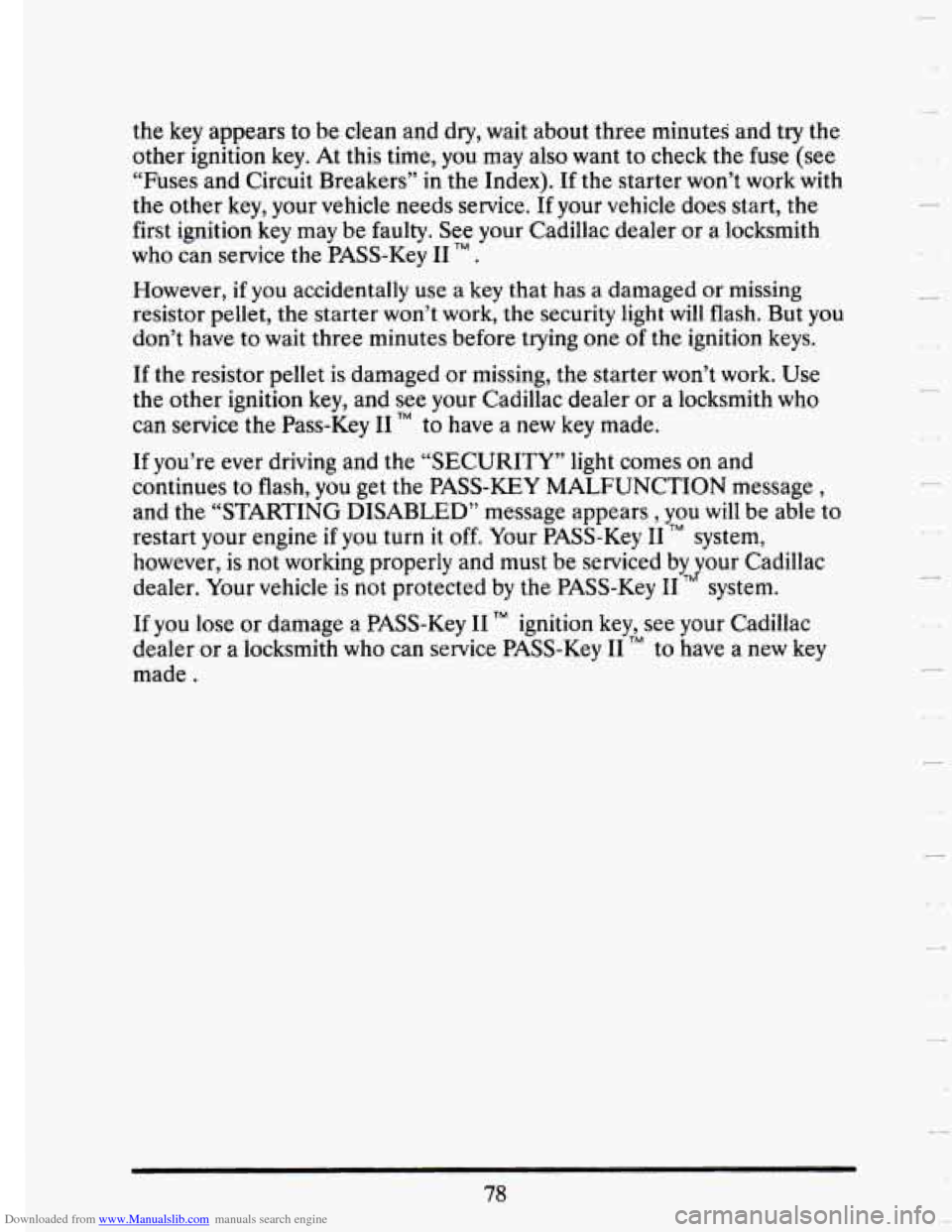
Downloaded from www.Manualslib.com manuals search engine the key appears to be clean and dry, wait about three minutes and try the
other ignition key. At this time, you may also want to check the fuse (see
“Fuses and Circuit Breakers”
in the Index). If the starter won’t work with
the other key, your vehic1.e needs service. If your vehicle does start, the
first ignition
key may be faulty. See your Cadillac dealer or a locksmith
who can service
the PASS-Key I1 TM .
However, if you accidentally use a key that has a damaged or missing
resistor pellet, the starter won’t work, the security light
will flash. But you
don’t have to wait three minutes before trying one of the ignition keys.
If the resistor pellet is damaged or missing, the starter won’t work. Use
the other ignition key, and
see your Cadillac dealer or a locksmith who
can service the Pass-Key
I1 TM to have a new key made.
If you’re ever driving and
the “SECURITY” light comes on and
continues to flash,
you get the PASS-KEY MALFUNCTION message ,
and the “STARTING DISABLED” message appears, you will be able to
restart your engine
if you turn it off. Your PASS-Key I1 TM system,
however, is not working properly and must be serviced bylour Cadillac
dealer. Your vehicle
is not protected by the PASS-Key I1 system.
If you lose or damage a PASS-Key I1
lM ignition key, see your Cadillac
dealer or a locksmith who can service PASS-Key I1
TM to have a new key
made.
u
c
-.
Page 115 of 407
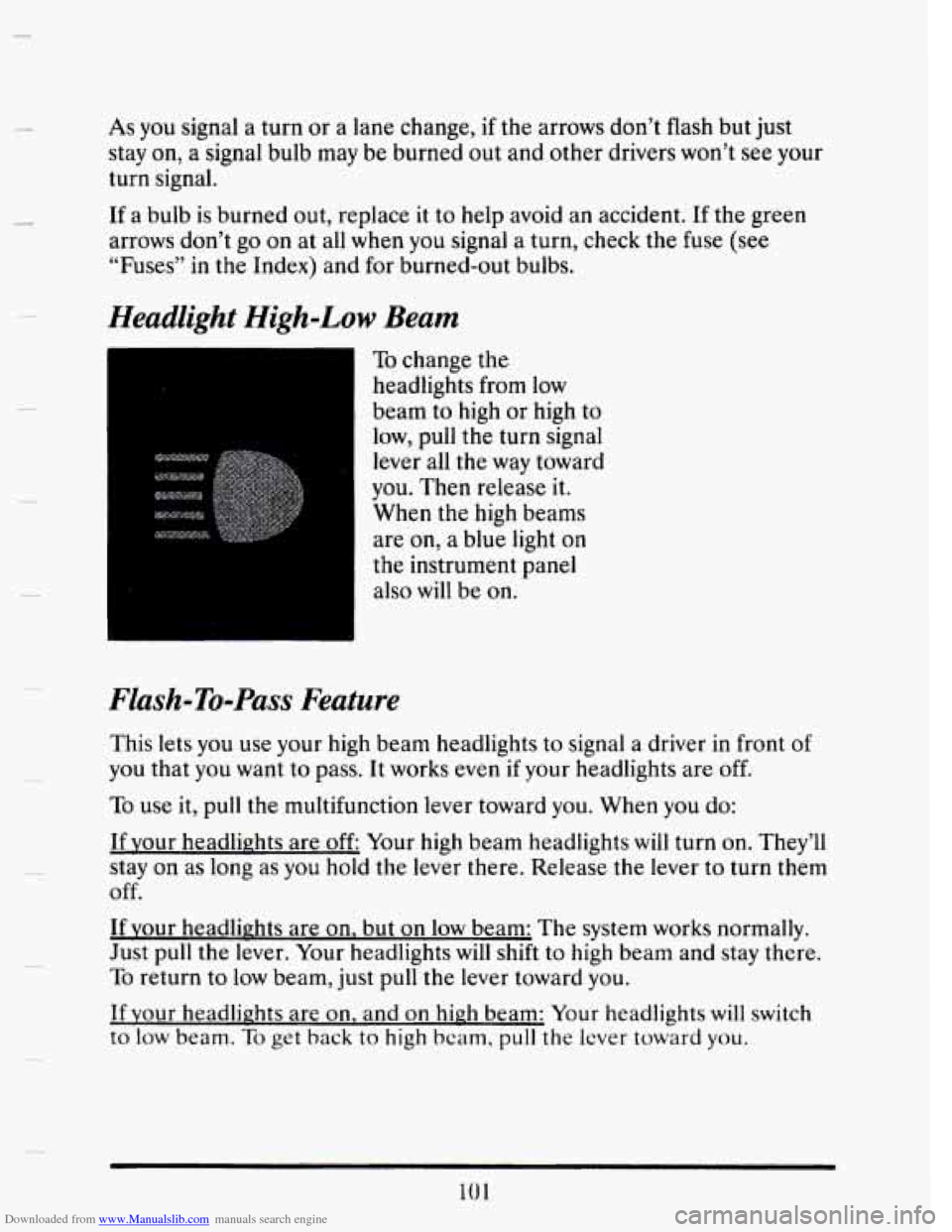
Downloaded from www.Manualslib.com manuals search engine c
As you signal a turn or a lane change, if the arrows don’t flash but just
stay
on, a signal bulb may be burned out and other drivers won’t see your
turn signal.
If a bulb is burned out, replace it to help avoid an accident. If the green
arrows don’t go on at all when you signal
a turn, check the fuse (see
“Fuses” in the Index) and for burned-out bulbs.
Headlight High-Low Beam
To change the
headlights from low
i beam to high or high to
low, pull the turn signal
lever all the way toward
you. Then release it.
When the high beams
are
on, a blue light on
the instrument panel
also will be on.
Flash-To-Pass Feature
This lets you use your high beam headlights to signal a driver in front of
you that you want to pass. It works even if your headlights are off.
To use it, pull the multifunction lever toward you. When you do:
If vour headlights are off Your high beam headlights will turn on. They’ll
stay on as long as you hold the
lever there. Release the lever to turn them
off.
If vour headlights are on, but on low beam: The system works normally.
Just pull the lever. Your headlights will shift to high beam and stay there.
To return to low beam, just pull the lever toward you.
If your headlights are on, and on high beam: Your headlights will switch
to low beam. To get back to high beam, pull the lever toward you.
10 1
Page 125 of 407
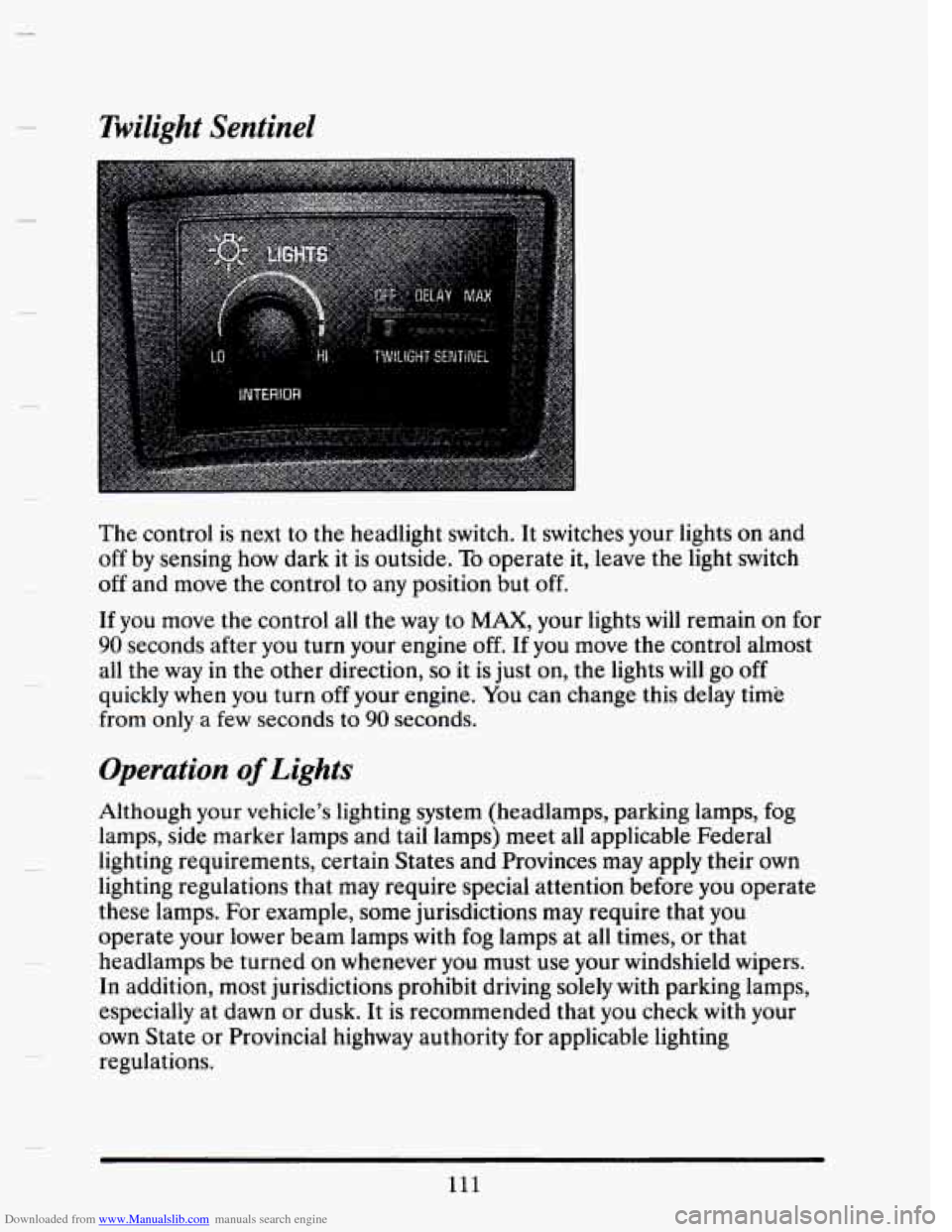
Downloaded from www.Manualslib.com manuals search engine Twilight Sentinel
I
The control is next to the headlight switch. It switches your lights on and
off by sensing how dark it is outside. To operate it, leave the light switch
off and move the control to any position but off.
If you move the control all the way to MAX, your lights will remain on for
90 seconds after you turn your engine off. If you move the control almost
all the way in the other direction,
so it is just on, the lights will go off
quickly when you turn off your engine. You can change this delay time
from
only a few seconds to 90 seconds.
Operation of Lights
Although your vehicle’s lighting system (headlamps, parking lamps, fog
lamps, side marker lamps and tail lamps) meet all applicable Federal
lighting requirements, certain States and Provinces may apply their own
lighting regulations that may require special attention before you operate
these lamps. For example, some jurisdictions may require that you
operate your lower beam lamps with fog lamps at all times, or that
headlamps be turned on whenever you must use your windshield wipers.
In addition, most jurisdictions prohibit driving solely with parking lamps,
especially at dawn or dusk.
It is recommended that you check with your
own State or Provincial highway authority for applicable lighting
regulations.
111
Page 141 of 407
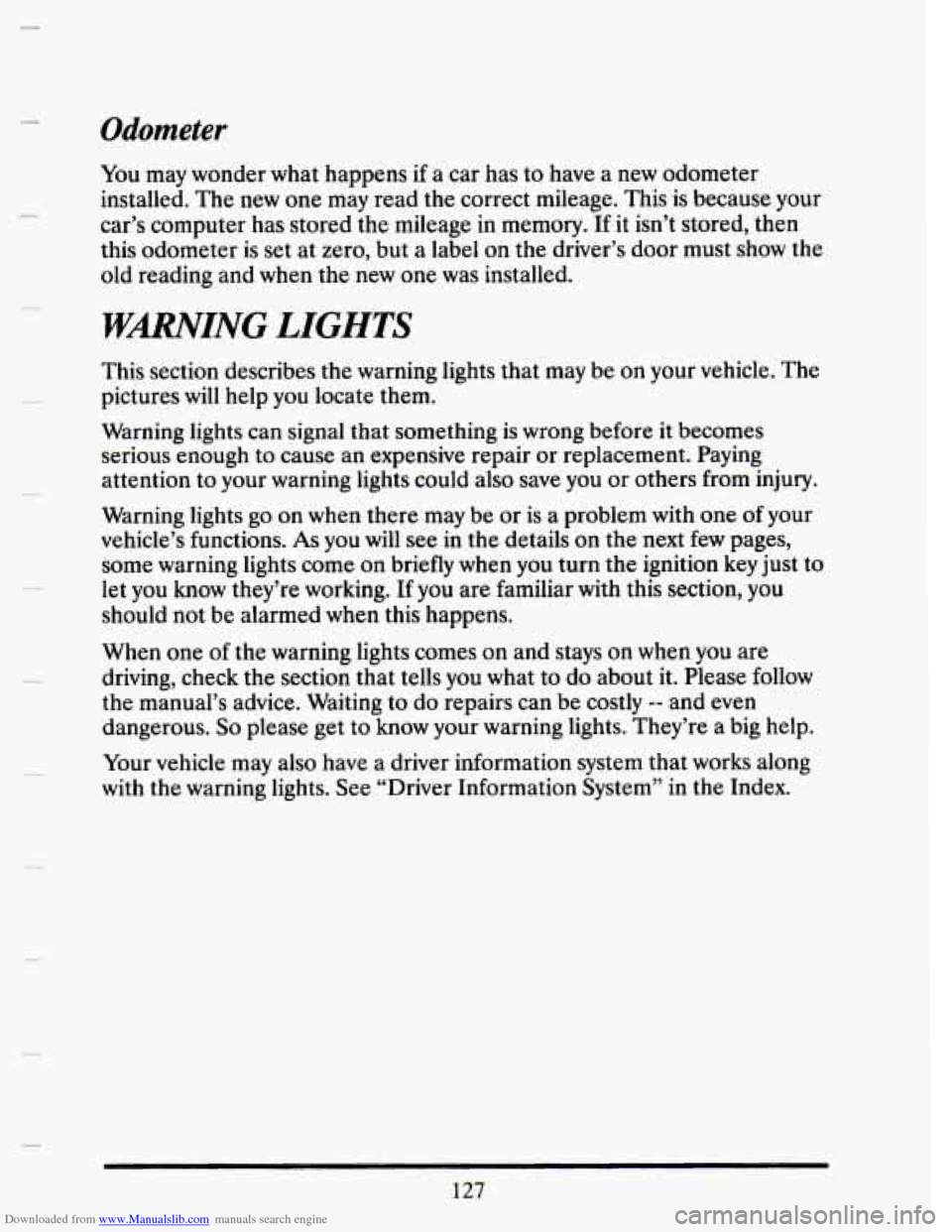
Downloaded from www.Manualslib.com manuals search engine Odometer
You may wonder what happens if a car has to have a new odometer
installed. The new one may read the correct mileage. This
is because your
car’s computer
has stored the mileage in memory. If it isn’t stored, then
this odometer
is set at zero, but a label on the driver’s door must show the
old reading and when the new one was installed.
WARNING LIGHTS
This section describes the warning lights that may De on your vehicle. The
pictures will help you locate them.
Warning lights can signal that something is wrong before
it becomes
serious enough
to cause an expensive repair or replacement. Paying
attention to your warning lights could also save you
or others from injury.
Warning lights go on when there may be or is a problem with one
of your
vehicle’s functions.
As you will see in the details on the next few pages,
some warning lights come on briefly when you turn the ignition key just to
let you
know they’re working. If you are familiar with this section, you
should not be alarmed when this happens.
When one
of the warning lights comes on and stays on when you are
driving, check the section that tells you what to do about it. Please follow
the manual’s advice. Waiting to do repairs can be costly
-- and even
dangerous.
So please get to know your warning lights. They’re a big help.
Your vehicle may also have a driver information system that works along
with.
. the ,. warning lights. See “Driver Information System” in the Index.